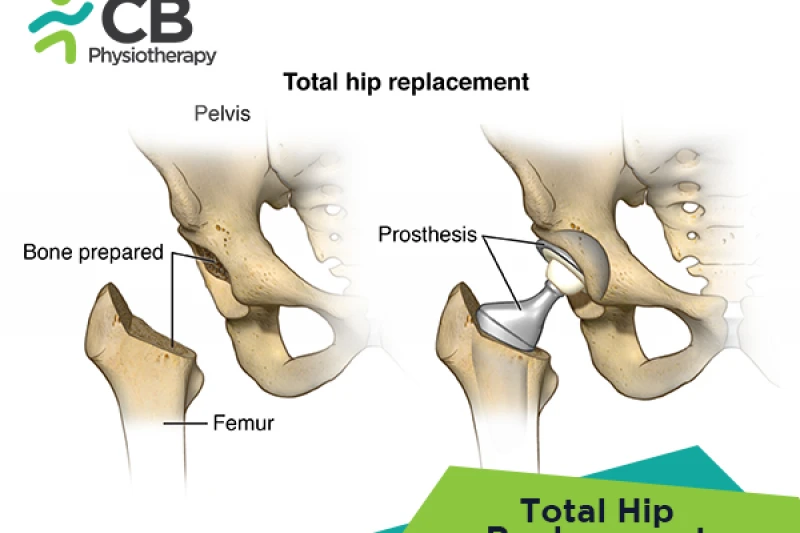
In Total Hip Replacement (THR), the damaged hip socket (acetabulum), and the damaged femoral sockets are removed and replaced by plastic, metal, or ceramic components depending on the age, needs, and condition. A total hip replacement (THR) is performed in patients with loss of cartilage in the hip joint.
· Total hip replacement (Posterior Approach) or (Anterior Approach).
· Partial hip replacement.
· Hip resurfacing.
Total hip replacement implants consist of the femoral component (inserted down the femoral canal), the bearing surfaces of the implant and the acetabular component (which is fitted into the patient's acetabular pelvic bone with or without cement).
Cemented
· Used for older or sedentary patients.
· Cemented acetabular components have been associated with increased rates of loosening. Therefore the use of cemented acetabular components has declined in recent years.
Cement-less
· This is an ideal choice for younger or more active candidates.
· The most commonly used composite for cement-less acetabular components is titanium alloy, which allows bone ingrowth. Cement-less acetabular fixation is done to solve the problem of loosening with cemented acetabular cups. A modular bearing surface is inserted into the inner aspect of the acetabular component which locks into place by a mechanism contained within the acetabular component. The acetabular component may accept bearing surfaces, made of ceramic, polyethylene, or metal.
Hybrid technique
· One part or both parts are inserted without cement. The artificial joint components are fixed into the bone with acrylic cement. The procedure where only one part is fixed with cement (usually the socket) is known as a hybrid hip replacement.
Disabling hip pain with functional impairment and significant bony changes and failed conservative measures are the indication for THR, these causes may include:
· Injury
· Ankylosing spondylitis
· Bone tumor
· Degenerative joint disease
· Developmental dysplasia of the hip
· Fracture or dislocation
· Avascular necrosis
· Fusion or pseudoarthrosis
· Hemophilia
· Legg-calve Perthes disease
· Osteomyelitis
Pathology of THR
Total hip replacement is also known as hip arthroplasty, it is the reconstruction surgery of the arthritic or the damaged hip joint. The end of the bone is capped by metal or plastic material. This surgery is done in patients suffering from severe arthritis or hip injury. The joint cartilage and also the surrounded bone of the hip are damaged. There is inflammation, which leads to stiffness and severe pain.
X-RAYS
X-rays help to determine the extent of joint damage.
MRI
MRI helps to determine the bone, muscular or ligamentous damage
Medication
Ibuprofen, Tylenol, vancomycin, Toradol (should be taken as prescribed by the doctor).
The physiotherapist uses the following techniques and modalities for regaining the functionality of the hip joint.
Cryotherapy:
Cryotherapy in combination with PROM exercises, elevation, and massage is used to decrease edema, developed due to inactivity or loss of voluntary movements.
Thermotherapy:
Thermotherapy can be used in combination with ROM exercises (twice daily) with sustained stretching technique (20 – 30minutes).
NMES:
Neuromuscular stimulations facilitate voluntary motor control and muscle strength.
Laser:
Cold laser is an effective treatment used for reducing pain thus increase joint range of motion.
Ultrasound:
Ultrasound decreases pain, increases range of motion, and decreases inflammation.
Rehabilitation protocol
Cemented techniques:
Cemented total hip: Weight-bearing with walker immediately after surgery.
Cement-less technique:
Touchdown weight-bearing with a walker after surgery.
Preoperative instructions
· Instruct in taking precautions for hip dislocation.
· Transfer instructions for In and out of the bed.
· Depth of the chairs: avoid deep chairs, avoid crossing legs while rising from the chair scoot to the edge of the chair then rise.
· Use elevated commode seat to aid in rising.
· Ambulation: instruct on the use of an assistive device (walker).
0-4 WEEKS – POSTOPERATIVE REGIMEN.
· Out of the bed in a stroke chair twice a day with assistance 1 or 2 days postoperative. DO NOT use a low chair.
· Begin ambulation and assistive device twice a day (walker)) 1 or 2 days with the assistance of the physiotherapist.
· Weight-bearing status for the cemented prosthesis. Weight-bearing as tolerated with a walker for at least 6 wk, then use a cane in the contralateral hand for 4- 6 months.
· Cementless technique: Touchdown weight-bearing with a walker for 6-8 wks, then use the cane in the contralateral hand for 4-6 months.
· A wheelchair may be used for long distances with careful avoidance of excessive hip flexion of more than 80 degrees while in the wheelchair therapist must check to ensure that the footrests are long enough. Place the triangular cushion in the wheelchair seat with the highest cushion point posterior, to avoid excessive hip flexion.
· Quadriceps sets
· Gluteus sets
· Ankle pumps
· Isometric hip abduction with self-assistance while lying.
· Return foot to starting position.
· Hip abduction–adduction
· ROM and stretching exercises
4- 6 WEEKS
Exercise progression
· Increase weight-bearing utilization. Maintain general precautions.
· Prone hip abduction.
· Mini squats.
· Bridges.
· SLR (flexion & abduction).
· Hip rotation (No IR, ER to 30 degrees).
· Calf raises.
· Standing hip abduction.
· Standing hip extension.
8-12 WEEKS
Exercises
· Hip abduction progress exercises from isometric abduction against self-assistance to therabands wrapped around the knees.
· Hip extension
· Hip flexion to 90 degrees.
· Knee flexion & extension.
· Theraband exercises, sports cords, and step-ups.
· Initiate general strengthening exercises develop endurance, perform cardiovascular exercise, and general strengthening of all extremities.
Activities
Golf when off crutches and steady, approximately 3-4 months.
Driving approx. 3 months.
· Joint Infection
Select your City to find & connect with our experts regarding Physiotherapy for Total Hip Replacement (thr)